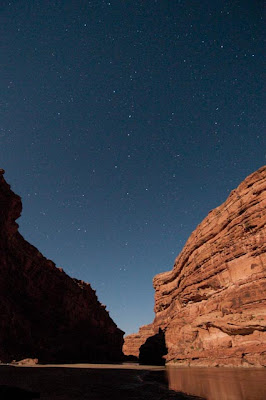


Shoot the moon and stars. It's a blast. Remember that the moon is lit by the sun so to record detail of the moon's surface generally requires a normal daylight exposure. Anything longer will yield a burned out white disk.
For stars, put your camera on a tripod, boost the ISO (try 800 or higher), open the lens to a large f-stop, and set the aperture on Bulb or time exposure. Also, turn off auto focus (all those tiny specks of light against black sky can drive the autofocus crazy), and set the distance to infinity. Try exposures in the 15 to 30 second range. Much longer and you will start to get star trails. In the photos above the cliffs show up well because of a nearly full moon shining on them.
Depending on your camera and photo software, you may be able to reduce digital noise for a sharper image. Have fun.